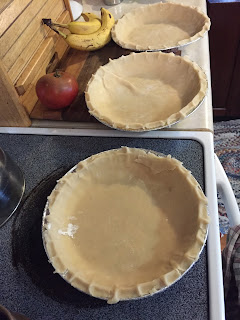It's funny how these old feelings hang around
You think they're gone...
No, no
They just go underground....
......You and me, we're like America and Russia
We're always keeping score
We're always balancing the power
And that can get to be a cold cold war..
...Joni Mitchell, 1976
After all these years, the strident beep of the Emergency Broadcast System alert still freezes me in my tracks. The recorded script was just part of the familiar background noise of my childhood, the menacing tones causing barely a ripple in everyday activities even as we awaited the message emphasizing the words 'This is only a test.' The EBS test was a much a part of life as fire alarm evacuations and huddling in the hallways, faces to the wall, during a tornado drill. Tornado warnings were a fact of life on the Illinois prairie and a genuine risk in a tract house with no basement: conversation stopped if the sirens went off. But we chattered away during an EBS test like it was a car commercial.
 |
| Emblem of the 351st Missile Wing, Whiteman Air Force Base |
Until the day we didn't. I was standing in the kitchen when the alarm came through the teak speakers in our dining room. My mother heard it too; my sister was playing in our back bedroom. "THIS IS NOT A TEST". The FM radio station we were listening to did not tell us what the actual emergency was, just that further information would be forthcoming. And then there was silence.
My father was out of town. We had no way to reach him. In confusion, we switched over to other radio stations, but several of them were broadcasting normal programming. Suddenly our routine sunny winter Saturday became terrible. We could only assume the worst: that Chicago was under attack by Soviet missiles.
It is a warm sunny afternoon in September at Whiteman Air Force Base near Knob Noster, Missouri. Though we stand in the middle of the middle of the U.S., a visit to the hangar of a B-2 Spirit or the National Guard Apaches reminds me I'm on the front lines of the defense of our nation. But to step inside the gate of the Oscar-01 launch control facility is to enter another era, of missiles, of fallout shelters, of the Emergency Broadcast tests: the Cold War . Oscar-01 was home to three Strategic Missile Squadrons which controlled 150 Minuteman II ICBMs from 1963 to 1995. The missile silos and command centers dotted the rural Missouri countryside in fourteen counties, silent sentinels in pastures and cornfields behind barbed wire on lettered state highways.
We sit in the former crew lounge in front of a map of sites and control centers, now owned by farmers and ranchers, storing hay or machinery, the facilities now empty, filled with debris or imploded: the last missile removed in 1995.
Minuteman missiles were based in the Midwest and Northern Plains, designed to fly across the North Pole to their targets in the Soviet Union. They were armed with a single nuclear warhead and could not be recalled once they were launched. From launch to target took 28 minutes.
The freight elevator delivers us to the underground control center as if it slogs through the weight of time itself. To our left is the machinery of survival after the unthinkable: an Allis Chalmers generator, scrubbers and filters for contaminated air, an air conditioning unit for the immense banks of non miniaturized computers, a suspended floor to absorb the shock of detonation, 750 gallons of water for the two man crew living stationed within the hardened concrete capsule and responsible for turning the keys that would launch the missile.
The commander and deputy commander were on duty for 24 hour shifts behind their multi ton doors; the sites in Missouri were connected by more than 1770 miles of hardened buried cable. The 150 facilities were built on bedrock anywhere from 60-90 feet deep, used more than 25,000 tons of steel and were completed in just over two years from ground breaking.
For those of us who grew up with the missile silos in their neighborhood (Orland Park Nike missile site) and the EBS as their sound track, this back stage visit is a sobering reminder; for those who came of age after the fall of the Soviet Union, the history seems as dated as Great grandma's woven plaid Lazy Boy rocker recliner and the deterrence of mutually assured destruction an acronym from the bad old days. The EBS false alarm of 1971 was revoked after an hour; that afternoon we went shopping for fabric. And I remember thinking how normal it was to be standing among the bolts of fabric, enjoying an innocent, harmless outing with my mother and my sister, when a few hours earlier, we had been shocked speechless with fright.
It may be that removing our shoes at airports and walking through metal detectors in public buildings is more a charade than an assurance of public safety. But the men and women that stood guard in Strategic Missile Squadrons like that of Oscar-1 exhibited the same dedication and fortitude to their duty as those manning the Apaches and maintaining the B-2 Bombers at Whiteman today.
It is a warm sunny afternoon in September at Whiteman Air Force Base near Knob Noster, Missouri. Though we stand in the middle of the middle of the U.S., a visit to the hangar of a B-2 Spirit or the National Guard Apaches reminds me I'm on the front lines of the defense of our nation. But to step inside the gate of the Oscar-01 launch control facility is to enter another era, of missiles, of fallout shelters, of the Emergency Broadcast tests: the Cold War . Oscar-01 was home to three Strategic Missile Squadrons which controlled 150 Minuteman II ICBMs from 1963 to 1995. The missile silos and command centers dotted the rural Missouri countryside in fourteen counties, silent sentinels in pastures and cornfields behind barbed wire on lettered state highways.
We sit in the former crew lounge in front of a map of sites and control centers, now owned by farmers and ranchers, storing hay or machinery, the facilities now empty, filled with debris or imploded: the last missile removed in 1995.
Minuteman missiles were based in the Midwest and Northern Plains, designed to fly across the North Pole to their targets in the Soviet Union. They were armed with a single nuclear warhead and could not be recalled once they were launched. From launch to target took 28 minutes.
The freight elevator delivers us to the underground control center as if it slogs through the weight of time itself. To our left is the machinery of survival after the unthinkable: an Allis Chalmers generator, scrubbers and filters for contaminated air, an air conditioning unit for the immense banks of non miniaturized computers, a suspended floor to absorb the shock of detonation, 750 gallons of water for the two man crew living stationed within the hardened concrete capsule and responsible for turning the keys that would launch the missile.
The commander and deputy commander were on duty for 24 hour shifts behind their multi ton doors; the sites in Missouri were connected by more than 1770 miles of hardened buried cable. The 150 facilities were built on bedrock anywhere from 60-90 feet deep, used more than 25,000 tons of steel and were completed in just over two years from ground breaking.
The Cold War was serious business...and the precautions and preparations were terrifyingly specific in dealing with an untested eventuality. Every contingency had its solution...up to and including an exit strategy for those trapped underground during a holocaust of fire above.
For those of us who grew up with the missile silos in their neighborhood (Orland Park Nike missile site) and the EBS as their sound track, this back stage visit is a sobering reminder; for those who came of age after the fall of the Soviet Union, the history seems as dated as Great grandma's woven plaid Lazy Boy rocker recliner and the deterrence of mutually assured destruction an acronym from the bad old days. The EBS false alarm of 1971 was revoked after an hour; that afternoon we went shopping for fabric. And I remember thinking how normal it was to be standing among the bolts of fabric, enjoying an innocent, harmless outing with my mother and my sister, when a few hours earlier, we had been shocked speechless with fright.
It may be that removing our shoes at airports and walking through metal detectors in public buildings is more a charade than an assurance of public safety. But the men and women that stood guard in Strategic Missile Squadrons like that of Oscar-1 exhibited the same dedication and fortitude to their duty as those manning the Apaches and maintaining the B-2 Bombers at Whiteman today.
"Those who expect to reap the blessings of freedom must, like men, undergo the fatigue of supporting it." --Thomas Paine: The American Crisis






























































